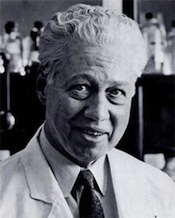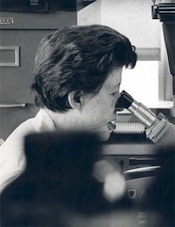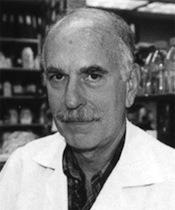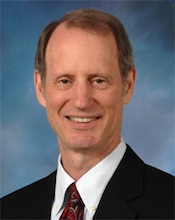




Origins of the Hematology Division
The Hematology Division was founded in 1938 by Carl V. Moore, MD, a native St. Louisan and graduate of Washington University School of Medicine. According to Oliver H. Lowry, MD, PhD, Moore “belonged to a new breed of clinicians who thought that basic medical science is too important to be left to the preclinicians” (from a biographical memoir (pdf) published by the National Academy of Sciences in 1994). His laboratory, which became a leading training center for hematologists during the 1940s, made fundamental contributions to our understanding of iron absorption, transport and storage. In a remarkable series of clinical investigations with William J. Harrington, MD, in the early 1950s, they established that thrombocytopenia in patients with idiopathic thrombocytopenic purpura (ITP) is caused by a stable factor in the globulin fraction of plasma. These studies involved intravenous injection of plasma from patients with ITP into normal volunteers – among them Moore and Harrington. In similar studies, Moore and his colleagues elucidated the mechanism of quinine-induced thrombocytopenia.
Early Scientific Achievements
Other notable achievements during the first two decades of the division included demonstration that febrile transfusion reactions are caused by sensitivity to donor leukocytes and platelets (Thomas E. Brittingham and Hugh Chaplin, Jr., MD), successful treatment of polycythemia vera with radioactive phosphorus (Edward H. Reinhard, MD, and colleagues), and identification of hemoglobin E (Virginia Minnich). Moore hired Virginia Minnich, who had a master’s degree in food science, in 1939 as his technician at a starting salary of $75 per month; she retired in 1984 as a full professor of medicine, the first person with neither an MD nor a PhD to achieve this rank at Washington University. She was an expert morphologist who trained several generations of hematology fellows in this area.
After Moore was appointed chairman of the Department of Medicine in 1955, Harrington became chief of the Hematology Division. A few years earlier, at the age of 28, Harrington had become the youngest member ever elected to the American Society for Clinical Investigation. He continued to investigate the pathogenesis and treatment of immune thrombocytopenia, and he studied the effects of high-dose glucocorticoids in patients with lymphocytic leukemia and lymphoma. In 1964, Harrington moved to the University of Miami, where he became chairman of the Department of Medicine. Elmer B. Brown, MD, led the division from 1964 until 1973. His research focused on several aspects of iron metabolism, including the function of transferrin and the role of chelating agents in the treatment of iron overload.
Continued Focus on Basic Research
Stuart A. Kornfeld, MD, and Philip W. Majerus, MD, joined the faculty in 1966, each having completed two years of residency in internal medicine and two to three years of research training at the National Institutes of Health (NIH). In 1973, they became co-directors of the newly designated Division of Hematology-Oncology. Kornfeld’s laboratory elucidated the mechanism by which lysosomal enzymes are transported from their site of synthesis in the rough endoplasmic reticulum to their final destination in lysosomes. Majerus’s laboratory discovered how aspirin inhibits platelet function and characterized many of the enzymes involved in inositol phosphate metabolism. In little more than a decade, they recruited Robert H. Allen, MD (1973), Thomas F. Deuel, MD (1977), George J. Broze, Jr., MD (1980), Douglas M. Tollefsen, MD, PhD (1980), J. Evan Sadler, MD, PhD (1984), Lee Ratner, MD, PhD (1985), Timothy J. Ley, MD (1986), and Stanley J. Korsmeyer, MD (1986), all of whom went on to have distinguished careers in academic medicine.
In 1973, most oncology patients at Barnes Hospital and The Jewish Hospital of St. Louis were cared for by private physicians; among them was Virgil “Bud” Loeb, Jr., MD, who served on the board of directors of the American Society of Clinical Oncology in 1970 and later as president of the American Cancer Society. Kornfeld and Majerus soon recruited Geoffrey P. Herzig, MD, to establish a bone marrow transplantation program within the division. Later, faculty members were recruited with expertise in solid tumor oncology, including Joanne E. Mortimer, MD, Joel Picus, MD, Paula M. Fracasso, MD, PhD, and Matthew A. Arquette, MD. Morey A. Blinder, MD, established the sickle cell anemia service and took primary responsibility for the hematology outpatient clinics, which currently schedule more than 3,000 patient visits per year. Other faculty members, including Elliott E. Abbey, MD, and Scot G. Hickman, MD, developed the Washington University hematology-oncology service at the St. Louis VA Hospital during the 1980s. In 1994, the bone marrow transplant and medical oncology programs were transferred to the new Oncology Division.
J. Evan Sadler, MD, PhD, became chief of the division in 2009. His laboratory dissected the mechanism of von Willebrand factor biosynthesis, identified mutations causing von Willebrand disease, and characterized the metalloprotease ADAMTS13, which is deficient in patients with thrombotic thrombocytopenic purpura. Sadler became President of the American Society of Hematology in 2010.
Major Research Contributions
Throughout its history, members of the Hematology Division have made important contributions to our understanding of blood diseases. Some additional examples include the following:
- Isolation of the vitamin B12 binding proteins transcobalamin I, transcobalamin II, and intrinsic factor by affinity chromatography (Robert H. Allen, MD)
- Definition of the molecular defects in paroxysmal nocturnal hemoglobinuria and dyskeratosis congenita (Monica Bessler, MD, PhD, and Philip J. Mason, PhD)
- Discovery of tissue factor pathway inhibitor, which defined a new pathway for regulation of blood coagulation (George J. Broze, Jr., MD)
- Isolation of platelet derived growth factor and definition of it as the first cellular oncogene (Thomas F. Deuel, MD)
- Isolation and characterization the enzyme required for cellular uptake of lysosomal enzymes (Rosalind H. Kornfeld, PhD)
- Discovery that over-expression of Bcl-2 causes B-cell lymphoma by inhibiting programmed cell death (Stanley J. Korsmeyer, MD)
- Identification of genetic elements that control globin synthesis (Timothy J. Ley, MD)
- Demonstration of the role of the LIM protein Ajuba in intracellular signaling (Gregory D. Longmore, MD)
- Development of improved retroviral vectors for treatment of lysosomal storage diseases (Katherine P. Ponder, MD)
- Demonstration that the tax gene of human T-cell leukemia virus type I causes leukemia in mice (Lee Ratner, MD, PhD)
- Discovery of the thrombin inhibitor heparin cofactor II and its role in arterial injury (Douglas M. Tollefsen, MD, PhD)
Impact of the Training Program
The Hematology Division has trained more than 200 clinical fellows, as well as numerous graduate students (PhD and MD/PhD) and postdoctoral research fellows, many of whom have become leaders in academic medicine. Twenty-five have become directors of hematology units at medical schools or the NIH, five have been appointed to chair departments of medicine, and one has served as dean of a medical school. Five faculty members or trainees have been elected to the National Academy of Sciences (Carl V. Moore, MD, Stuart A. Kornfeld, MD, Philip W. Majerus, MD, Stanley J. Korsmeyer, MD, and Stuart F. Schlossman, MD) and 10 to the Institute of Medicine. Since 1966, 26 faculty members or trainees have been elected to the American Society for Clinical Investigation (ASCI) and 20 to the Association of American Physicians (AAP). Three members of the faculty have been elected president of the ASCI (Carl V. Moore, MD, Philip W. Majerus, MD, and Timothy J. Ley, MD), two as president of the AAP (Carl V. Moore, MD, and Stuart A. Kornfeld, MD), and three as president of the American Society of Hematology (Carl V. Moore, MD, Philip W. Majerus, MD, and J. Evan Sadler, MD, PhD). Seven faculty members or trainees have received the Dameshek Prize or the E. Donnell Thomas Prize, bestowed by the American Society of Hematology for outstanding scientific achievement.
Text written by Douglas M. Tollefsen, Stuart Kornfeld, and J. Evan Sadler for the Department of Medicine Centennial Celebration, September, 2010